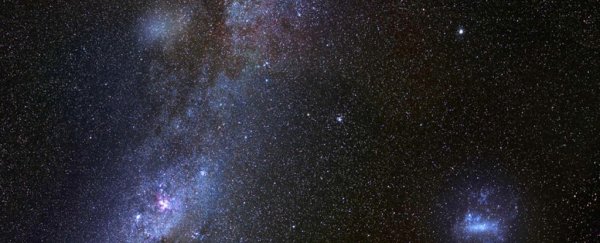Just as moons orbit planets, planets orbit stars, and stars orbit galactic cores, galaxies can be orbited by other, much smaller galaxies. The Milky Way has several of these hangers-on, most notably the Large and Small Magellanic clouds, the only two of our galaxy's satellites visible to the naked eye.
Now, thanks to Gaia data - the most comprehensive map of our sky ever compiled - astronomers have just found another one. And it's absolutely huge - as big as the Large Magellanic Cloud, or about one-third of the size of the Milky Way.
In the picture above, it's the dim glow in the upper left of the image, located adjacent to the Milky Way (bottom left), with the Large Magellanic Cloud pictured on the bottom right.
Since it's located in the southern constellation Antlia (The Pump), it's been given the name Antlia 2.
So how did Antlia 2 manage to escape detection for so long, especially since we have known about the Large Magellanic Cloud since at least 964 CE?
A few ways. The first is that it was neatly concealed behind the Milky Way's disc. The second is that it has extremely low density, which means it's not giving out much light. In fact, it's 10,000 times fainter than the Large Magellanic Cloud - its representation in the image above is brightened, so we can see it.
It is, by far, the most diffuse galaxy ever found. It's even much fainter - about 100 times - than the incredibly faint ultra diffuse galaxies, which lack star-forming gas, and therefore the ability to make new stars.
This could mean Antlia 2 is just the remains of a galaxy long dead. Or, as astronomer Gabriel Torrealba of Academia Sinica in Taipei put it: "This is a ghost of a galaxy".
The team found the galaxy on a hunt for Milky Way satellites based on a type of star called RR Lyrae variables. These stars are very old and metal-poor, and are commonly found in dwarf galaxies and globular clusters.
As per the name, they are also variable stars, which means their light varies on a very regular timescale - around half an Earth day. This means they can be used as standard candles to calculate the precise distances between Earth and the star, as discovered by Henrietta Leavitt early in the 20th century.
The team found a group of these stars in the Gaia data, but when they checked the location against databases of known objects, there was supposedly nothing there. So they conducted further observations and managed to obtain the spectra of 100 red giant stars just before Antlia 2's position became obscured by the Sun, where it was expected to remain for several months.
All the stars they studied were moving together, which is how they confirmed the existence of the huge, previously unknown Antlia 2, lurking out there beyond the Milky Way.
Based on the team's observations, Antlia 2 lies some 424,000 light-years from Earth, and is around 11.2 billion years old. Simulations suggest that much of its material was gobbled up by the Milky Way - the same fate that lies in wait for the Magellanic Clouds.
"The simplest explanation of why Ant 2 appears to have so little mass today is that it is being taken apart by the Galactic tides of the Milky Way," said astronomer Sergey Koposov from Carnegie Mellon University.
"What remains unexplained, however, is the object's giant size. Normally, as galaxies lose mass to the Milky Way's tides, they shrink, not grow."
This means it likely had to have started off as much bigger than it is now, although that is yet to be determined. And there's also some question as to Antlia 2's size.
As New Scientist reports, according to astronomer and RR Lyrae expert Gisella Clementini of the National Astrophysical Institute in Italy, the calculation used by the team to determine the distance to the RR Lyrae group included an error. When calculated correctly, they are only 260,000 light-years away.
But, according to Torrealba, that miscalculation only changes the distance to the RR Lyrae stars, not the red giants the team studied, which they confirmed using two separate methods.
So either the RR Lyrae stars are in front of Antlia 2, which means the galaxy's discovery was the result of a miscalculation and therefore extremely lucky, or they are part of the galaxy, but merely the closest edge.
Either way, there is no doubt the team has discovered something strange in our neighbourhood.
"Compared to the rest of the 60 or so Milky Way satellites, Ant 2 is an oddball," said astronomer Matthew Walker, also from Carnegie Mellon University.
"We are wondering whether this galaxy is just the tip of an iceberg, and the Milky Way is surrounded by a large population of nearly invisible dwarfs similar to this one."
The team's paper has been accepted into the journal Monthly Notices of the Royal Astronomical Society, and can be read on the preprint resource arXiv.
